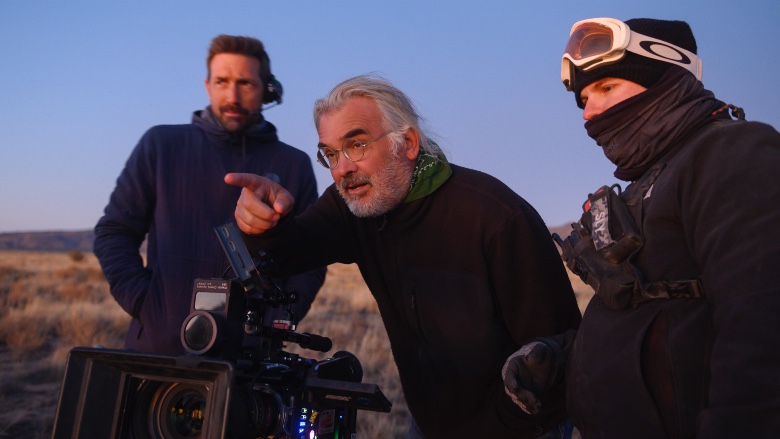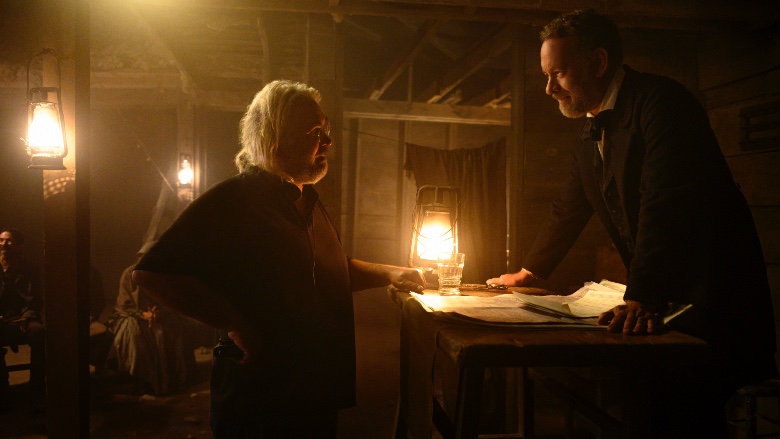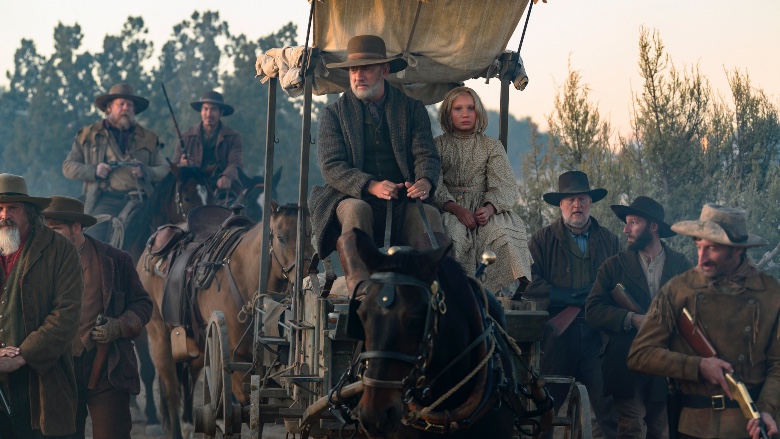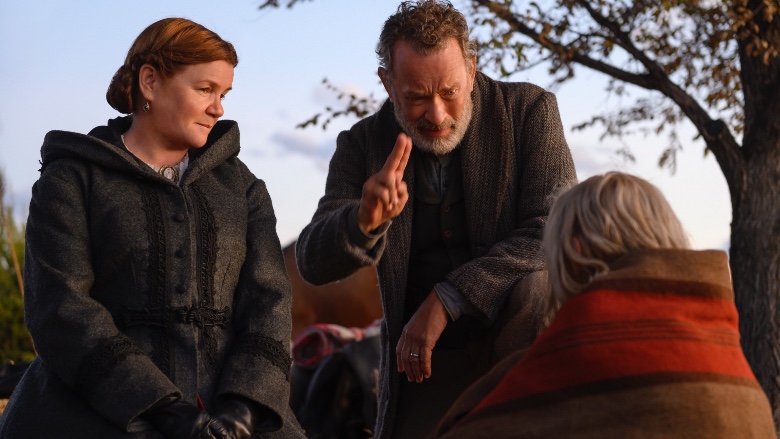
Although filmmaker Paul Greengrass has been directing movies and television since the mid-80s, his 2002 film Bloody Sunday, about the “Troubles” in Northern Ireland, was what finally got him notice as a filmmaker. That led to a fairly large leap into studio movies, directing Universal Pictures’ action sequel, The Bourne Supremacy – Greengrass would team with actor Matt Damon for two further Bourne movies, as well as the Iraq-set Green Zone.
The next big milestone in Greengrass’ career was his 2006 film United 93, which covered the hijacking of one of the airplanes on 9/11, which had such an impact that it garnered the filmmaker an Oscar nomination for his direction, as well as the first of his three BAFTA nominations for direction.
For his latest film, Greengrass has reunited with Tom Hanks, star of his 2013 film Captain Phillips, but this time, Hanks plays Captain Kidd, a former Civil War soldier who travels around the South reading news stories to anyone willing to pay a dime. When he encounters a savage girl who has been living with Natives, played by Helena Engel, he swears to take her across the country to her estranged aunt and uncle. The unlikely duo meet many challenges on this journey.
Although we still officially have two more months of eligibility for the Oscars and various guilt and society awards, you will not find a better movie for craft than News of the World, between Dariusz Wolski’s stunning cinematography, the luscious score by James Newton Howard, the undeniable editing of William Goldenberg, production design by David Crank (Knives Out), costumes by Mark Bridges and the sound work, which helps pull the viewer into the journey. Needless to say, Greengrass put together a fantastic team for his very first Western.
Below the Line got on the phone with Mr. Greengrass last week for the following interview.
Below the Line: When a filmmaker makes a Western, at least these days, it almost seems like they’re making a statement. What was it about Paulette Jillses’ novel that made you decide to tackle the genre?
Paul Greengrass: I think it was the fact that when I read the novel, it could have felt like… it’s set in the shadow of the Civil War at a time when America was bitterly divided, searching desperately for a way to heal. When I read the story, it just felt so resonant of today. I’ve been wanting to do a film that would try to explore where hope lies in our dark world. We’re in a lot of difficult, aren’t we? I just thought this story of the lonely news reader moving from town to town, telling stories, he’s really weaving a thread that binds us back together again, with the healing power of storytelling. Then he meets the mysterious girl, and they go off on a sort of journey, and it’s a fairly and ostensibly to take her to what he thinks is her surviving family. What it really becomes is a journey for them both to find where they belong in this broken, divided world. So I found it very inspiring. It made me think a lot about my daughters. You want for them to move into a better world than the one we’ve got at the moment.

I wanted to make a film about what the road for healing looks like. Of course, that road is dangerous and full of difficulties, you have to overcome challenges and all the rest of it. Ultimately, they both find themselves and each other, of course.
BTL: Do you have any favorite Westerns that you went back to for reference, either for yourself or your different departments?
Greengrass: The Searchers, I suppose would be the obvious reference for this one, because it felt to me that it was kind of The Searchers in reverse in a funny way. The Searchers is the journey out to find the girl. This is the journey to take the girl home, so it’s sort of the reverse, and that felt very timely for today.
BTL: I often ask directors about how they choose their various department heads and who they work with. A few of the people on this you’ve worked with before, and a few like Dariusz Wolski and James Newton Howard, I was amazed by the fact you’d never worked with before. Can you talk about putting together the team for this one?
Greengrass: Let’s talk about Dariusz first. As a filmmaker, you’ve always gotta evolve and grow and do different things. I wanted to explore a different tempo, and I wanted to make a more classical-looking movie, if I can put it that way or classically-shaped. I’ve always admired Dariusz’s work obviously, and I thought it would be an interesting collaboration coming at it from different points. We got on like a house on fire, but it was also a really interesting, creative dynamic between us, because we were sort of evolving. I wanted to obviously make it look different, but still be authentically mine, if you know what I mean. That’s a difficult circle to square, but I thought that Dariusz did it brilliantly, because I think it’s a beautiful-looking film yet it is a classic Western in its feel, but it still feels authentically like one of mine.
James, I’ve known for a while. I’ve always wanted to work with James. This just happened to be the one where it came together. It was just a dream. We had a lot of fun, and the concept of the score… I remember when we first met, what I wanted was a small consort of players who have come back from the Civil War, and they’re all broken down. The score is the sort of thirst of that consort to find harmony again. That’s absolutely what James did. I think it’s an absolutely fantastic score. He used a lot of very old instruments to get that quality, and then he wrote the most beautiful music, I think. It’s just the most exquisite music, and I think it speaks both to big screen and enormous and then also, incredibly intimate. I think it’s just such an emotional score and such a beautiful score. Don’t you think?

BTL: I absolutely 100% agree. Working with the art department, it seems like you built a lot of these towns on location rather than using the standard backlot. All the towns looked very different from anything we’ve seen.
Greengrass: We worked very hard. I think David Crank [the Production Designer] did a brilliant job. We were on a few ranches in New Mexico, and what we did was sort of mix and match and change and augment buildings a lot. It was just about being very precise. We didn’t have a lot of money, but David just worked wonders, and put us there. You felt the dust and the mud and the hastily-built quality of it all. I loved the feel of Dallas at night with the lamps. It was a combination of David and Dariusz, [Costume Designer] Mark Bridges and Jean [Ann Black] in makeup. I just thought they all coalesced. It was a beautiful group, and Jeff Dashnaw, of course, is our Stunt Coordinator who was fantastic. He worked on Westerns before, and he knew that world and the horses. Because we were out on location. In many ways, the making of the film became an adventure. If you think of that scene in the middle of the movie, the shootout, where they go up the rock bluffs. Those were incredibly high and incredibly difficult to get to, and then the whole crew had to climb up on rope. It was two hours to get up and two hours to get down, then there were incredible safety issues when we were up there. People had to be roped on, and then there were a lot of rattlesnakes up there, too. The whole thing became like an adventure, but I think everybody loved that and embraced the challenges of being out in the desert, in the dust, being really hot during the day and freezing cold at night. There was quite a lot of wet work, and the rain, and everyone just embraced it. It was the most stressful movie to make, I must tell you.
BTL: I’m glad you brought up the shootout, because it’s an amazing 12-to-15-minute sequence, and having the benefits of a screener, I watched the movie a second time and even rewound to watch that sequence again. You talked a little about the challenges of that scene but it must have been hard for Dariusz to shoot, since he’s shooting outside in daylight. How many days did it take to shoot that?
Greengrass: I think it was about ten days, something like that, off and on. We didn’t have an awful lot of time. This wasn’t an enormous budget movie. We had enough money, but we had to be tidy and expeditious, but that was a real challenge, because it had everything really. A lot of our problems had to do with [the fact that] we could only use Helena for so many hours a day. That was an additional complication and then you’ve got animals, weather… we had everything really, right down to the rattlesnakes.
BTL: But those rattlesnakes came with the region not from a snake wrangler…
Greengrass: Oh, we had snake wranglers, but we didn’t bring them there. The snake wranglers were there to take the rattlesnakes away and sort ‘em, and that was a lot. You’d be busy doing your thing, and suddenly, the wrangler would come up and go, “Don’t move. We’ve just seen one. It’s about eight feet behind you.” That sort of thing. [laughs]
BTL: If I was Helena’s age, I’d be so freaked out by the snakes. I wouldn’t be able to concentrate on working.
Greengrass: What’s amazing is, when you’re doing it, you kind of just get lost in the whole thing. As I say, it becomes a filmmaking adventure in a good way. And I think everybody loved it — I did. For me, it was like a dream come true. I grew up with those Westerns, when I was a kid, you know? I never thought I’d ever get the chance to make one, so I was absolutely in heaven just the whole way through. It was exciting to shoot a movie under the big sky and feel the ghost of John Ford out there somewhere. You feel as if you’re clambering up on the shoulders of a giant, trying to pay homage to him, but also be true to your own movie. As a filmmaker, it was just a filmmaking challenge. It was fantastic.

BTL: Did you and Dariusz feel that you could get all of the coverage you needed for the shoot-out with the time and constraints you had?
Greengrass: Yeah, there was nothing I think that we missed. Look, you always need more time, you can always use it, the point of our films is that they’re made in real time within constraints. If I go and talk to young directors at film school, I’ll always tell them, “Here’s the first thing you need to know. You need to see your boundaries as your friend not your enemy, because the creative work is done within the boundaries, not when there are no boundaries. Whatever your boundaries are, whether their budgetary or the lights going down, or you’ve got to wrap a child actor, or the horses get upset and don’t want to ride. Whatever those challenges are, they’re the challenges that make you think outside the box and innovate and improvise. That’s where your film comes alive.” Filmmaking is a lot like an airplane meal, it’s not ready-packed or bite size. It’s a living thing or it should be, and things are gonna go wrong, and you are going to run out of time, but it’s what you do in those moments that makes your film come alive. I think.
BTL: I wanted to ask how much post you had to do in the pandemic, because that has affected a lot of productions and post on a lot of movies.
Greengrass: We finished shooting about this time last year, so we started post in January, and then of course, the pandemic came along in early March, and we were posting in London. Billy Goldenberg [Editor] was over, and we were all over there. When lockdown came, everybody went home, Billy went home. What we did to do was we had to make a new plan, essentially, on the run, to the point that I was making — just a minute or two ago — we had to change all our plans. Billy turned his front room into a cutting room. We were all connected up in our various houses. It took us a few weeks, actually, to deal with the technical problem. But then, actually — and it shows you how technologies improved – really, it actually worked amazingly well. You can finish a film virtually. It’s harder work maybe, because we finished all the FX over here. We still had a lot of the sound work over here. I was working on London and Los Angeles time simultaneously for about six months, which is quite hard. But James did the music. It was a wonderful thing to see the music being recorded at Abbey Road. I was in my office, James was in his studio in Los Angeles. We were all different parts of the world, but we all connect together, and actually, I don’t think it affected post. It required us to embrace technology, which is a good thing. It shows you now how amazingly sophisticated post-production technology is.
News of the World hits theaters nationwide on Friday, December 25, aka Christmas Day.
All photos by Bruce W. Talamon, courtesy Universal Pictures.





